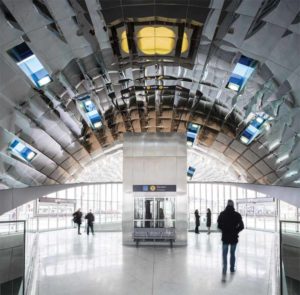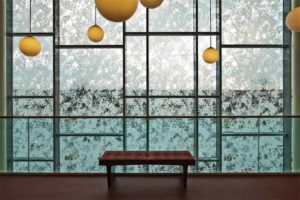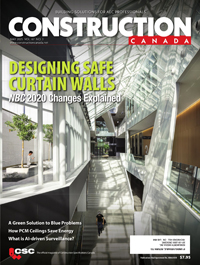Myth versus reality: Revealing the curtain wall capabilities of modern steel
Myth 2: Steel structures are not energy efficient

Photos courtesy TGP
Many curtain wall framing materials have a reputation for high thermal conductivity compared to other elements of the building envelope. Design teams often pair framing systems with low-emissivity (low-e) glass or other energy-efficient glazing to help boost centre-of-glass (COG) thermal performance values. The problem is the system’s overall thermal efficiency remains significantly less effective where the captured or retained glass edge meets the supporting frames.
With Canada’s predominantly subarctic climate and long history of stringent standards for energy efficiency in new construction, many design teams therefore opt for thermally broken aluminum frames. By incorporating thermal breaks (i.e. separations between the inner and outer frames), they can help reduce the heat flow associated with the material’s high thermal conductivity (i.e. approximately 124,500 joule [118 Btus] per hour).
Contrary to popular belief, thermally broken aluminum frames are no longer the only high-performance alternative. Steel’s thermal conductivity is approximately 74 per cent less than that of aluminum (i.e. approximately 32,707 joule [31 Btus] per hour). This is equivalent to that of thermally broken aluminum frames. Even more importantly, due to the design of steel profiles, some advanced steel frames do not require a traditional thermal break. Steel frames without a thermal break need less metal to support the glazing than traditional aluminum frames, and therefore, reduce the pathway for heat transfer and offer greater resistance to heat transfer than aluminum systems.
U-value and AAMA 1503, NFRC 100 and 200
When combined with clear insulated glass units (IGUs) with low-e coatings, independent testing agencies have calculated steel’s modelled U-values to be between 0.36 to 0.39 U-value, or thermal transmittance tests, including American Architectural Manufacturers Association (AAMA) and United States-based National Fenestration Rating Council (NFRC’s) thermal modelling and testing regimens, 1503, Voluntary Test Method for Thermal Transmittance and Condensation Resistance of Windows, Doors and Glazed Wall Sections, and NFRC 100, Procedure for Determining Fenestration Product U-factors, and/or NFRC 200, Procedure for Determining Fenestration Product Solar Heat Gain Coefficient and Visible Transmittance at Normal Incidence.
With NFRC 100 and 200, simulations and/or physical testing are used to determine frame materials’ U-values. NFRC 200 additionally measures fenestration product solar heat gain coefficient (SHGC) and visible transmittance at normal incidences. During NFRC 100 computer simulations of steel frame materials, IGUs and low-e coatings, the system’s U-values were 0.31. With 25-mm (1-in.) IGUs comprising clear glass and non-gassed airspace as well as triple glazing, steel U-values have been recorded as low as 0.19. It is important to note these are approximate values only. Actual values will vary depending on specific product configuration per project requirements.
Support for high-performance glazing
Steel can also provide the necessary support for heavy triple-glazed IGUs, and/or for a wide variety of glass thicknesses, whereas most aluminum glazing systems can only handle a single glazing infill thickness. This is paramount as traditional framing materials may not be able to support the required loads associated with high-performance glazing, simply due to its size, thickness, and/or weight.
This is not the case with steel. Due to the material’s strength, some steel curtain wall systems can support glazing infills up to 76 mm (3 in.) thick and weights up to 112 kg/m2 (23 lb/sf). This far surpasses the typical thickness (i.e. 45 mm [1 ¾ in.]) and weight (i.e. 48.8 kg/m2 [10 lb/sf]) of triple-glazed units. In sum, the material can support high-performance glazing with marginal effects on the design intent.
Myth 3: Steel curtain wall systems have little impact on LEED requirements

Steel curtain wall systems can also help design teams meet LEED requirements, from optimizing energy performance to contributing toward daylight and views, further trumping misconceptions about its impact on energy inefficiency and daylighting (Figure 3).
The Canada Green Building Council (CaGBC) explains, “Since 2005, LEED buildings have eliminated nearly 2.5 million [carbon dioxide] CO2 tonnes of greenhouse gas (GHG) emissions annually, diverted nearly three million tonnes of waste from landfills, and saved 24 billion litres of water per year, benefiting all Canadians.” Continuing with Canada’s legacy to advance green building, green professionals can use steel to help earn points in the following categories.
Energy and atmosphere (EA)
Steel can help design teams optimize energy performance in this category “beyond the prerequisite standard to reduce environmental and economic harms associated with excessive energy use.” As discussed earlier, steel’s lower thermal conductivity means it functions as a better thermal insulator than aluminum, leading to decreased energy consumption.
Indoor environmental quality (EQ)
To earn points for daylight, which seeks “to connect building occupants with the outdoors, reinforce circadian rhythms, and reduce the use of electrical lighting by introducing daylight into the space,” there are three options. The first requires annual computer simulations for spatial daylight autonomy. The average spatial daylight autonomy must have a value of at least 40 per cent. Minimum thresholds for option 2 (computer simulations for illuminance take place at the equinox) and option 3 (measure illuminance) are 55 per cent for regularly occupied spaces.
Steel’s aforementioned tall free spans, made possible in part by steel back mullions, can help design teams meet these daylight requirements. For example, curtain walls utilizing these long, continuous steel elements can handle up to 12-m (40-ft) free spans in a single member without splicing. With steel curtain walls, natural light can penetrate deep into a building’s interior easily, increasing illuminance (Figure 4).
The steel mullions are further available in a variety of sizes and shapes, such as box, I-beams, and T-shapes. Compared with aluminum’s basic ‘box’ back counterpart, steel T-shapes are slimmer and allow for more unobstructed views. LEED requires “a direct line of sight to the outdoors via vision glazing for 75 per cent of all regularly occupied floor area.” Steel back mullions, along with tall free spans, can help achieve quality views.
Before getting started
With these three common steel myths busted, architects and specifiers can rest assured that steel- framed window and curtain walls can resist air and water penetration, and eliminate the potential for corrosion, while earning LEED credits for energy efficiency and EQ. Taller free spans of glass, larger glass lites, sleeker profiles, and mullion versatility also make steel an attractive choice for curtain wall applications.
To set-up design teams for success, early involvement with steel framing manufacturers and glazing subcontractors is crucial. During these discussions, hammering out the fine details like the proper anchor/embed can lead to more precise fabrication and subsequent installation, saving time on the jobsite. Bigger picture topics such as schedule, budget, and project needs must also be addressed before construction begins. They are key to identifying and solving potential pitfalls before they arise.
For instance, take a steel curtain wall in a public library. The project consisted of two different, yet compatible steel systems to save costs (Figure 5). A laser-welded steel profile system was used for the vertical mullions, which provided expansive views of the library’s surrounding city hall and parks in line with the library board’s vision. The verticals were mated to a rolled profile system for the horizontals. The horizontals mirrored the look of the verticals, and resulted in lower project costs than if laser welding had been used throughout.
Given the move toward higher performance buildings, it is also advisable to consider how steel curtain walls fit within the overall building enclosure and the move to whole building commissioning. With decreased air loss, tighter water resistance, and lower U-values steel can help the design team meet tougher energy performance specifications.







